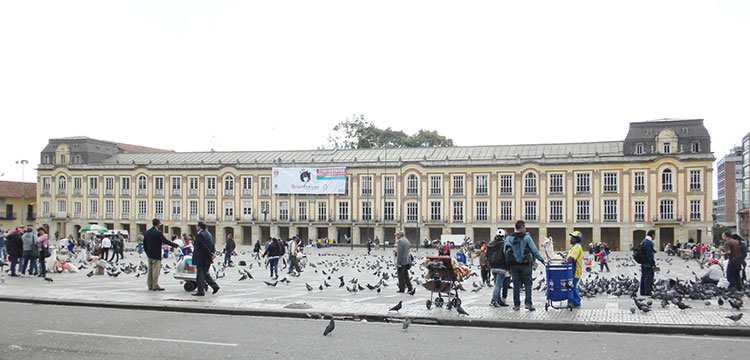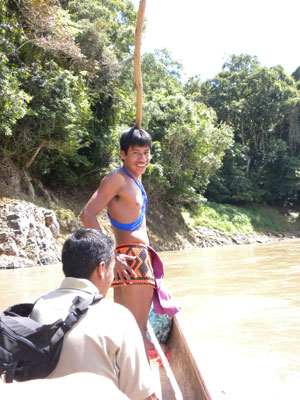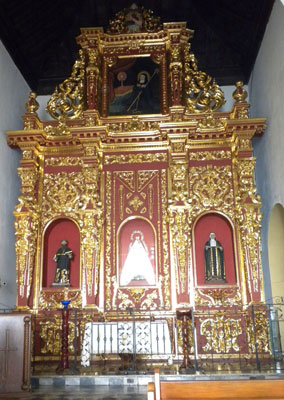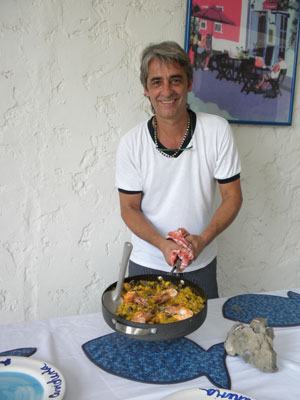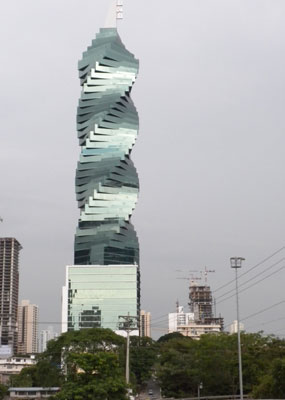Exploring the colonial heritage of Panama and Colombia
This article appears on page 36 of the March 2013 issue.
by Dorothy Van Horn, Manhattan Beach, CA
On a December cruise on the Royal Princess through the Panama Canal in 1988, I watched the locks open and close, allowing our ship to pass, and resolved that someday I would return to Panama to observe the operation from on land. At a port stop after the locks, Cartagena, we were allowed only a brief visit, so I was determined to return to explore that colonial city as well.
Big Five Tours & Expeditions (Stuart, FL; 800/244-3483) offered a May 2012 itinerary that fulfilled my long-anticipated desire to revisit Panama and Colombia.
The nitty-gritty
I’ve traveled with Big Five since 1994 and have always received top-notch service. Their predeparture documents are detailed, informative and very helpful. Assistance is available 24/7 through their concierge White Glove Service to handle problems, disasters and special requests (e.g., theater tickets or dinner reservations), and they even establish online blogs for those traveling with them.
Big Five Tours organized a private tour for my travel companion, Barbara Namour, and me. We toured Panama May 5-10, then continued to Cartagena, where my friend Garth Steinert Greene joined us for our week-long tour of Colombia.
Travel insurance was purchased through Squaremouth. It was in January 2003 that I first contacted Chris Harvey to purchase travel insurance from his company, Squaremouth (St. Petersburg, FL; 800/240-0369), and for over nine years of purchasing insurance from Chris’ reliable company, I have been extremely satisfied with his staff’s personal and professional concern in finding the best, most reasonably priced insurance for my preexisting conditions.
In Panama City, Barbara and I paid single supplements during our 5-night stay at DeVille Hotel. Garth and I roomed together in Colombia.
My land cost was $4,660 plus $345 for the flight on Copa Airlines from Panama City to Cartagena. The internal flight from Cartagena to Armenia (Colombia) and on to Bogotá cost $254. I flew in business class from Los Angeles to Panama City, returning from Bogotá to Los Angeles using my American Airlines frequent-flyer miles; $85 went to Uncle Sam for the flight.
On May 5th, Alex Hemans of Cheap Shuttle Taxi & Limousine Services (310/462-9566) drove me to LAX for my American Airlines flight to Panama City. Alex is professional, caring and personable, and I’ve used his services since 2002. He always arrives 15 minutes prior to my requested pickup time. My one-way transfer cost $20 plus gratuity.
Getting around
Barbara and I were greeted by a guide from Big Five’s ground operator in Panama, EcoCircuitos, upon our arrival in Panama City. Irving Ricardo Cantoral led us to our van, driven by Belisario Cordoba. During our five days in Panama, they treated us royally and like friends.
Irving was an outstanding, enthusiastic, highly professional and accommodating guide. His pride and love of Panama were reflected throughout our sojourn, and his knowledge of the country’s history, geology, fauna, flora and culture was invaluable.
Without a doubt, one of the best drivers I’ve had during the numerous trips I’ve taken was Belisario. He expertly maneuvered our van on city and country roads with our safety constantly in mind. Belisario spoke little English, but he always understood and anticipated our needs. During our walking tour of Panama City, Belisario guided me to places most travelers don’t frequent.
Barbara and I were so delighted with both gentlemen that we invited them to join us for lunch throughout our five days in Panama. Thanks to them, we enjoyed delicious Panamanian meals in nontouristy eateries.
City stay
The 4-star DeVille is a beautiful boutique hotel located in the financial district — perfect for businessmen but not for travelers. Restaurants and shops are several blocks away on tipsy sidewalks.
Because of my room’s spaciousness, however, it was one of my favorites during our Big Five tour. The room was rated “deluxe” but was actually a junior suite. It was comfortable and cozy, especially when I turned off the freezing A/C. The room was dimly lit, with cable TV and complimentary WiFi.
My queen-sized bed was exceptionally comfortable, and a pillow menu was available! Unfortunately, the window next to the bed had an unacceptable view of the nearby building’s blank, white wall.
The large, marble walk-in shower did not have grab bars or a nonslip shower mat on its slick floor. Fortunately, I travel with a portable grab bar.
Within sight of our hotel was the iconic F&F Tower, formerly Revolution Tower. This unique contorted tower is 793 feet high. The design of the 52-floor building twists around a central axis, giving the tower the dramatic appearance of a double helix.
Touring Panama City
The first stop for our half-day morning tour was a visit to the Panama Canal’s busy Miraflores Locks, on the Pacific side. Having observed the working of the locks from the ship on my first trip, it was intriguing to watch the activity from the shore. We listened to a narrative about the locks’ history and operations as we watched a freighter pass through the canal.
The nearby Panama Canal Authority’s museum, with its lifelike displays and movie presentation, provided marvelous insight into the incredible, challenging feat of building a canal connecting the Pacific and Atlantic oceans on the narrow land bridge between North and South America.
To accommodate today’s megaships, the Panamanian government approved, in 2006, the Third Set of Locks Project, which will provide a new passageway along the present canal. It’s scheduled to be complete by 2014.
Our tour of Panama City included Casco Viejo (Old City). A UNESCO World Heritage Site, it was constructed as a walled city to protect its citizens from pillaging and plundering like the attacks led by infamous Captain Henry Morgan on neighboring Panama Viejo.
Most attractive were the original buildings, residences, shops, cathedrals, convents and monasteries built in the Spanish- and French-colonial styles.
The Atlantic side
During our second morning, we left the hectic, high-rise city for a drive through the serene, verdant tropical countryside. Via the Trans-Isthmian Highway, we crossed the isthmus for the locks at Gatún, on the Atlantic side.
Along the way we passed several expat communities. Approximately 25,000 Americans live in Panama because of its tropical atmosphere, unspoiled beaches and mountains and a less-expensive cost of living as compared to what it costs to live in the US, Europe, Canada or large parts of the Caribbean. Most importantly, residents receive quality health care.
The best place to view activities on the Panama Canal is Gatún. Gatún is less touristy than Miraflores and is much closer to the action; we were the only ones there.
Afterward we crossed the Panama Canal by drawbridge and drove on to Fort San Lorenzo in Colón. Constructed in the 16th century, it’s strategically located on a high mountain with a panoramic view of the Chagres River.
The third day was the highlight of our sojourn. We drove to the Chagres River, where we boarded a wooden piragua for the river journey to a far-flung village of the indigenous Emberá. The spectacular tropical scenery and the three Emberá villages along the river’s banks distracted me from dwelling on the blistering, excruciating experience of being perched precariously on a hard, uncomfortable, narrow board.
After several hours, we finally landed, disembarked and climbed a steep mud bank. The villagers greeted us warmly, shaking rattles and thumping a drum. When we arrived at the meeting house, women were weaving baskets, a source of the village’s income.
Following the formal greeting (translated by Irving) by the village spokesman, Julio, we were served a typical lunch. Using our fingers, we devoured delicious fried tilapia and plantains presented on a wooden plank. Dessert was pieces of a huge watermelon contributed by Irving.
Following Julio’s explanation of life and customs in his village, he and a young lady modeled their native garb. Afterward we stretched our legs, browsing the hand-carved tagua/ivory nuts, woven baskets and masks available for sale. Before departing, we watched the women and men of the village dancing to the beat of wooden sticks, a drum and round gourd rattles.
After our last day’s breakfast, we thanked the DeVille’s personable staff for their warm hospitality. At Tocumen International Airport, we bade a sad “Adios” to Belisario and Irving.
I never cease to be amazed by the impeccable service of many international airlines, and I was not disappointed during our hour-long Copa Airlines flight from Panama City to Cartagena, Colombia.
During that brief time, flight attendants cheerfully served us beverages and a light lunch. We were not charged for our luggage or delicious meal. My economy-class leather seat was comfortable, and the flight was absolutely pleasant because of the crew’s friendliness and willingness to please.
Cartagena
Our guide, Gerson Pajara, from Colombian Journeys, the local operator, and my friend Garth, whom he’d met when she arrived shortly before our disembarkation, greeted us, Gerson assisted us with our luggage and we continued on to the Anandá Hotel for our 3-night stay.
Upon checking into the Anandá, we discovered that our rooms were not junior suites, as stated by the hotel on our documents, but were standard rooms. However, we didn’t have time to argue because we had a scheduled afternoon tour outside the walled city. Because of its military architecture, Cartagena is a World Heritage Site.
The Castillo San Felipe de Baraja on San Lázaro Hill dominated the Cartagena skyline and was an awesome sight. Built during the Spanish-colonial era, the castle is renowned as the most important military castle of its type in the Americas.
Neither Barbara nor I was able to climb the steep hill to tour the castle site, so we visited the neighboring shops and streets while Garth, guided by Gerson, had a quick look around.
Next, we drove up a zigzagging road to the top of Cerro de La Popa, a 500-foot-high hill shaped like a ship’s stern. The view from this highest point of the city was spectacular.
On top of the hill is a 400-year-old, white stone monastery, Convento de la Popa, established in 1607. The chapel’s cool air was a welcome relief from the afternoon’s oppressive humidity.
The focal point of the chapel is an ornate, 22-karat gold-leaf altar. In the altar’s center is an image of the Virgen de Candelaria, who is credited with delivering Cartagena from being ravaged by disease and pillaged by pirates.
Back at our hotel, conveniently located in the heart of the city’s historic district, our cramped room in the renovated 16th-century colonial house had complimentary wireless and wired high-speed Internet access. It also had air-conditioning, which we turned off because of an efficient ceiling fan.
Gerson suggested that we three dine in the historic region near the city’s wall at the popular La Vitrola (Calle de Baloco No. 2-01; phone 575 6600711). After making the mandatory reservations, we asked the friendly Anandá staff to call a taxi, which took us to the corner nearest to the hidden restaurant’s entrance. The miniature portal was guarded by a formal-looking security guard, who smilingly allowed us to pass.
My “Aurora spaghetti” with sauce on the side, a bottle of water and Club Colombia beer, with gratuity, cost 38,047 pesos ($21.50).
Touring the city
The next morning, our humid, 3-hour walking tour was led by Victoria Olivo Berrio, who subbed for Gerson. She spoke unaccented English and was energetic, personable and a font of knowledge.
We walked by fashionable boutiques, art galleries, tempting local eateries and street vendors selling pineapple, mangoes and other tropical fruits.
The cobbled streets were charming, as were the colonial balconies filled with colorful flowers riotously spilling over wooden rails. Victoria commented that during the annual flower festival competition, balconies were artistically decorated with profusions of bright, spectacular blossoms, as homeowners vied to win the prize of a year’s tax exemption on their property.
In Plaza de Bolívar, we visited one of the oldest cathedrals in Colombia, though I found the many sculpted metal figures situated throughout the plaza more fascinating than the towering, ancient cathedral. The plaza also houses the Palace of the Inquisition and the Gold Museum.
The palace was filled with creepy, gory torture contraptions. At the entrance there was a variety of “tests” that the inquisitors used in order to determine whether or not an individual was a heretic. A scale measured an “appropriate weight” for the accused. If it indicated the individual was under- or overweight, he was dragged to the guillotine and put to death.
In the next room there were displays of instruments used to torture a confession from the accused. Written accusations by citizens proclaiming their neighbors’ heresies were thrown through a tiny barred window with a cross above it.
Sobered by the atrocious exhibits, we left the plaza for the Museo del Oro. The Gold Museum possesses valuable, stunningly beautiful pre-Columbian gold artifacts and some of the oldest ceramics in the Americas.
Cartagena’s cuisine
My favorite places to eat are restaurants frequented mostly by locals. Garth and I discovered Nidia F. Torres, a hole-in-the-wall a few blocks from our hotel. My lunch was the restaurant’s specialty, delicious lengua (tongue) soup, preceded by an appetizer and accompanied by a cerveza. The total for this popular meal was 11,200 pesos ($6.30).
One of the activities I was looking forward to was meeting, touring and cooking with Jorge Escandon, proprietor and chef of La Cevicheria (Centro Historico, Calle Stuart No. 7-14, Barrio San Diego, Cartagena, Colombia; phone 011 57 5 6601492). Jorge had appeared on Anthony Bourdain’s TV program, “No Reservations.”
We drove by the local markets and stopped at the popular Narcobollo (Cra. 17 Avenida California No. 25-68, Frente al Parque de Manga; phone 660 6670), a self-serve restaurant. I salivated over the sight and aroma of the many Colombian foods offered which are not available in “touristy” restaurants.
Jorge selected items for us to taste, and it was fun to sample the array of arepas (a flat bread often filled or topped), bollos de coco (coconut buns), meat sticks, sausages, tamales and many unfamiliar foods. The pork rinds were exceptionally crispy, and the freshly baked bread, pastries and sweets were very tempting.
With difficulty, I tore myself away for our drive to a supermarket and Jorge’s restaurant, where he picked up items for our lunch of ceviche and shrimp paella with coconut rice. We drove from the city through the countryside to his relaxing beachfront home, where we watched him prepare our special lunch, which was absolutely delicious.
Returning to the hotel, the three of us decided to spend the afternoon walking off our lunch. We traveled to Centro Artesanal (Las Bóvedas) by taxi. This artisans’ market has many shops where everything from local crafts to T-shirts are sold. Prices were reasonable, and some shopkeepers would bargain.
Gerson joined us for our carriage ride through the old and new city on our last night in Cartagena. At night, the colonial city was lively and vibrant. Our horse’s hooves clicked against the cobbled streets as we passed noisy, crowded plazas of families and friends enjoying the evening’s cool air. The sounds of vendors hawking food were accompanied by rhythmical, traditional instruments played by three or four musicians, the music reflecting the influence of Colombians, Spaniards and Africans.
Gerson was my guest for our last dinner in Cartagena, at Candé (Centro, Calle Estanco del Tabaco No. 35-30; phone 5 668 5291). I ordered pork-knuckle soup, and Gerson enjoyed a fillet of sea bass plus vegetables, sparkling water and coffee. We each had a Club Colombia beer. The total tariff, including gratuity, was 77,121 pesos ($43.70).
While we dined, a couple in traditional garb danced among the crowded tables. Gerson said we were watching the cumbia, which was banned as inappropriate until the mid 20th century. Accompanied by the beat of drums and wooden sticks, cumbia originated as a courtship dance of the slaves.
The five days we spent in Cartagena were charming, captivating and, we felt, safe. No longer the world’s drug capital, it’s now an alluring food capital.
On to Armenia
An Avianca flight took us to Armenia, Colombia, where we were greeted at El Edén Airport by our guide, Alejandro Garcia. Our driver, Miguel Grisales, spoke excellent English with an American accent, having lived in New York City during his formative years.
From the airport we traveled into the Valley of Cocora, part of Los Nevados National Park. The natural beauty of the landscape was overwhelming. The area’s splendor jolted nostalgic memories of my younger years on Kaua’i.
Alejandro informed us that Hacienda Bambusa, where we were headed, is part of what UNESCO lists as a “coffee cultural landscape of Colombia.”
Our arrival at the hacienda was warmly greeted. I loved the rustic, homey atmosphere of the casa, a home renovated to accommodate guests who enjoy relaxing, being pampered, contemplating nature’s beauty and viewing the magnificent, awesome Andes.
Bambusa’s courtyard and entranceway were a profusion of crotons, palms and orchids. On the lanai near the courtyard was a bookcase with travel books plus coffee tables with magazines in English and Spanish. Our fellow guests hailed from England, France, the States and Malaysia.
On this trip, Hacienda Bambusa, with its rugged ambiance and naturally beautiful surroundings, was my favorite lodging — a numero-uno place for meditation and relaxation.
Garth’s and my rustic room was more spacious than that of the Anandá Hotel’s, and it opened onto a patio with a spectacular view.
My first night’s meal of a mound of deboned duck with a tantalizing red wine-berry sauce was a gourmand’s delight and very filling. My next evening’s meal, traditional sancocho (soup with meat and vegetables), was unique and palate pleasing. Both meals were proficiently and specially prepared by 25-year-old chef Cristian Monroy.
Founded in 1889, Armenia is located between a gorgeous green valley and a range of high, bluish-green mountains, the Cordillera Central, one of the three branches of the Andes. Besides being a coffee region, Cordillera Central has several volcanoes.
Next, we took an afternoon walking tour of El Mariposario, part of the Jardín Botánico del Quindío (Centennial Ave. 15-190, Km3 [website in Spanish only]), a butterfly-shaped enclosure housing over 1,200 species of lepidopterans. Butterflies flittered around us and landed on vegetation, our shoulders and our hair.
Leaving the enclosure, Garth and I wandered through part of the 37 acres of natural forest, one of the few such areas remaining in the coffee region. Ferns, bamboo and other plants, some over 200 years old, were among the 850 species surrounding us in the forest.
Bogotá
Our three nights at Hacienda Bambusa were too brief. I was tempted to cancel the upcoming tour in Bogotá to remain at the casa and explore the area more extensively. After breakfast, with a fond “Adios” to the hotel staff, I reluctantly departed for Armenia’s airport.
While we waited for our delayed Avianca flight in the business lounge, we watched a TV announcement of a bomb in Bogotá that had gone off on the crowded Caracas Avenue, close to the financial district. Later reports blamed a disguised motorcyclist who had attached it to Fernando Londono’s armored SUV while it was stuck in heavy traffic. (Londono, 68, is a hard-line, former government minister.)
We watched his bodyguards lead the dazed, injured former politician, bleeding from head and chest injuries, away from the disaster. Londono’s driver and one of his bodyguards were killed.
The news was sobering, as we were booked at Hotel Avia 93 in the financial district. In spite of the event, as seasoned travelers we didn’t feel threatened or afraid for our safety. I felt secure, as Big Five Tours has a stellar record for assisting clients during unexpected events.
Our flight finally departed for Bogotá’s El Dorado Airport, where we were met by our guide, Constanza. Our van driver was Angel.
Before we checked into our hotel, a walking tour took us to the main attractions of Colombia’s capital city. Our first stop was the Plaza de Bolívar, dominated by an enormous statue of Simon Bolívar, celebrated as a hero for freeing the country from Spain. The plaza was alive with hectic activity: flocks of cooing, fluttering pigeons; vendors touting pony and llama rides; strolling Colombians, and sidewalk vendors hawking various unfamiliar foods. I loved the potpourri of sights, sounds and smells, which I found more enticing than the silent buildings surrounding the plaza.
From Plaza Bolívar, we walked past Plaza San Carlos, surrounded by palm trees and 17th-century buildings on three of its sides. Opposite San Carlos is the Church of San Ignacio. A block farther, we saw the Palacio de San Carlos, once the home of Colombia’s president, and, opposite it, Bogotá’s cultural center, Teatro Colón.
Finally, we reached Bogotá’s Gold Museum, which has the world’s largest collection of pre-Hispanic gold, over 55,000 gold pieces from 13 individual societies. These societies regarded gold as a sacred metal. They believed it was a recipient of the sun’s energy, and it was revered as a symbol of fertility and life. Gold, to them, did not represent wealth; it served as a sign of prestige and an offering to the gods.
Not all of the gold pieces are on exhibit, only about 6,000 at a time. I wandered through the museum’s second- and third-floor exhibits. Each display was informatively described in English and Spanish.
To relieve one’s eyes from the glittering, attractive gold pieces, there are 20,000 bone, stone, ceramic and textile artifacts. My favorite exhibits were those of personal adornment, including nose, pectoral and nipple ornaments and animal-adorned diadems.
Request granted
After a long day, we drove to Hotel Avia 93. The hotel was brand new and ultramodern. Its excellent location was close to Parque de la 93, with many dining options.
After we were settled into our rooms, I contacted Colombian Journeys, Big Five’s local operator, and, for the first time in all of my travels through 185 countries and seven continents, I requested a different driver and guide for our last day in Colombia.
Being with Angel was like being on Mr. Toad’s Wild Ride. His driving was jerky; he wove in and out of traffic, didn’t slow down at curves and veered into the path of an oncoming car, narrowly avoiding an accident.
And, from our guide, Constanza, there was what I felt was confrontational behavior that I found difficult to ignore. I was unwilling to have us being uncomfortable and stressed, spoiling our memories of an excellent, fun and educational Colombian tour.
Characteristic of all of Big Five Tours’ representatives, Paul, the ground operations manager, was very understanding and accommodating, as he consistently was throughout our Colombian visit.
During the remainder of our stay, he would call to ascertain that we had no problems and were enjoying our stay. He even resolved Garth’s and my inconvenience at Bogotá’s Hotel Avia 93, where the room Garth and I were to share was too small for a rollaway bed. He requested a single room for Garth, gratis. His concerns and professionalism contributed to my enduring pleasant memories of Colombia.
We met our new guide, Jorge, and driver, Juan, on the last day of our Colombian adventures. Jorge Leon was an excellent guide. He was very knowledgeable, accommodating, energetic and personable. And, most importantly, Juan was a safe and experienced driver.
A final day
Our first stop that last morning was at the Botero Museum (Calle 11 No. 4-41), which we had missed the previous day. Fernando Botera’s amusing and skillfully executed paintings and sculptures reflect humor, kindness, cruelty, whimsicality and biting satire.
He donated 123 of his works to the museum, whose construction he orchestrated. Botero’s donation was on condition that none of the collection be removed or borrowed and that each piece must remain in the exact space he designated for it.
Also on exhibit were works by Picasso, Renoir, Dalí, Matisse, Monet and other artists from the late 19th to early 20th centuries.
During our 2½-hour drive north toward the town of Zipaquirá, we passed several villages that looked worth exploring. Zipaquirá is famous for its Salt Cathedral, built into an abandoned area of a rock-salt mine. It’s also renowned for one of the oldest human settlements in the Americas, El Abra. The cave system at El Abra was inhabited by Late Pleistocene Homo sapiens.
We were lucky to have Jorge on this visit. He was very familiar with the area, as he was born in a village near the Salt Cathedral and worked in the salt mines for several years. Upon our arrival at the mines, he was warmly greeted by former colleagues.
Jorge expertly led us through the maze of underground small chapels that illustrated Christ’s suffering. Subdued purple, gold and blue lights spotlighted the finely cut rock-salt sculptures at each Station of the Cross. The shrine, at the bottom of the former salt mine, had three sections, representing the birth, life and death of Jesus.
Approximately 3,000 people attend Sunday Mass there, though the cathedral has no bishop and is not officially recognized by the Catholic Church.
My last meal in Colombia was Garth’s treat, to celebrate my April birthday. We dined and wined at Pesquera Jaramillo (Calle 93 No. 11-31; phone 011 571 2565494). Her paella was outstanding, and my squid in black ink, a dish I’d always wanted to try, was absolutely delicious. The service was impeccable.
For those leery of traveling to Colombia, be assured that, perhaps, the only risk is a desire to return, especially to Hacienda Bambusa and Armenia. We found Colombians to be friendly and hospitable, the food was delicious, and the scenery was spectacular.
Revisiting Panama and Colombia with Big Five Tours & Expeditions was a fulfilling, educational and memorable experience.

